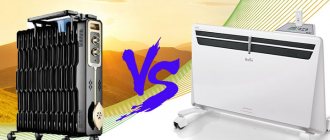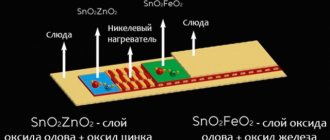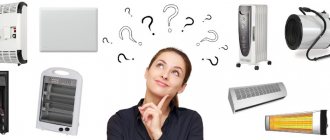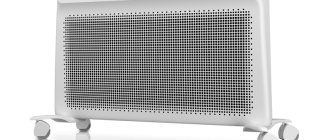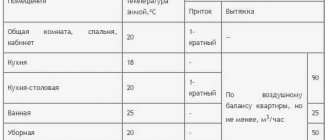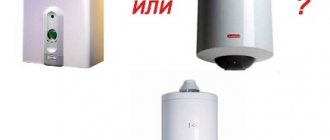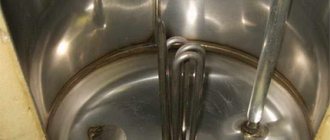General requirements for space heating
There are clear criteria by which you can immediately evaluate the capabilities of a particular electrical appliance. For example, for an unheated room these indicators look like this:
- for an area of up to 6 sq.m – 550 Watt;
- from 7 to 9 – 750 Watt;
- from 10 to 20 – from 1000 to 1750.
To heat a room with an area of more than 20 square meters, you need a heater with a power of 2 kW or higher. We will try to determine which class to choose based on a comprehensive analysis of the capabilities of the devices.
What is an oil heater
The oil heater is a sealed housing made of stainless metal alloys. In high-quality products, these are aluminum-containing compounds; cheap Chinese products are guilty of using simple steel, while relying on tightness (the radiator does not rot from the inside) and an external protective coating.
It’s worth noting right away that the best combination of price and service life will have a product in the middle and high price range.
The operating principle of an oil heater is quite simple:
- inside a sealed metal case, which consists of separate blocks (for a large area of contact with air), there is transformer oil;
- after turning on the device, the electric heating element or a group of them heats the coolant;
- when the oil temperature reaches the value set using the regulator, heating stops;
- after the oil has cooled by a certain number of degrees, the heating elements are turned on again and return the coolant to the temperature specified by the user.
The oil cooler is self-sufficient. Depending on the volume, the warm-up time may vary. But after the device is in operating mode, it shows excellent characteristics of economy and efficiency. The heating elements are turned on for a short time, the radiator almost always has the same temperature.
Operating principle and design of oil heater
This device is a sealed steel container with a heating element filled with transformer oil (“spindle”). Heating is controlled by a thermostat. The design of this device includes the following elements:
- Capacity. It can be in two versions: flat panel, in the form of a radiator;
- Heating elements. Most models have heating elements installed;
- Oil, which plays the role of a coolant with a high heat capacity coefficient and a long cooling period;
- A control unit that includes a thermostat, temperature controller, and power switch.
Oil heater device
The operating principle of the device is based on the phenomenon of convection. After voltage is applied to the device, the heating elements begin to heat the oil that fills the radiator. When the user-defined temperature is reached, the thermostat turns off the heating elements. After the temperature of the coolant drops by several degrees, the heating elements turn on and reheat it to the set temperature.
Depending on the mounting method, all oil radiators are divided into the following types:
- wall;
- floor;
- desktop;
- ceiling;
- for cribs.
Floor-standing model Unit with built-in fan Wall heater
To increase the speed of heating the air in the room, some models are equipped with a fan that evenly distributes the heated air masses.
Advantages:
- Large heat transfer area due to the shape and size of the container;
- Silence. These devices (except for models equipped with a fan) do not have mechanical components;
- Environmentally friendly. The devices do not affect the quality characteristics of the air and do not emit unpleasant odors;
- Safety. Thanks to the sealed container and relatively low surface heating temperature, such devices are completely safe to use;
- Economical. The high heat capacity of the coolant allows heating elements to be turned on rarely, which significantly saves energy;
- Reliability and durability. There are no moving parts in the device, so, in principle, there is nothing to break. The sealed tank does not allow oxygen to interact with its internal surface, which eliminates the effects of corrosion.
Flaws:
- Long initial heating time.
- Heavy weight. This drawback is not critical, since each floor-standing model is equipped with wheels for easy movement.
How does a fan heater work?
The fan heater is also not complicated. Here the heat source is a red-hot coil or thin metal plates.
When air is blown, it heats up and enters the volume of the room. The general operating principle is similar to the mechanics of an oil cooler:
- at start, the fan heater reaches its technical maximum;
- voltage is supplied to heat the heat-producing metal parts until the thermostat records the average temperature in the case specified by the user;
- There is no complete cessation of energy consumption - the fan runs constantly.
But there are also key differences between the two classes, which will be mentioned later. Here we note the main thing: the fan heater is strongly tied to the air flow; if it is impossible to supply the full volume for blowing, the device will turn off due to internal overheating protection, releasing noticeably less heat into the room than stated by the manufacturer. A covered fan heater will not be able to “survive”, unlike an oil radiator.
Which is better, a fan heater or an oil heater?
As you can see, each of the devices has its own advantages and disadvantages. Accordingly, the choice will be determined by the user himself. Let's consider the main criteria that will help you buy the right device:
- Noise level. When viewed strictly, both devices are not completely silent. If a person is a light sleeper and is able to wake up from any rustle, then the sound of both the fan heater and the oil heater working will disturb him. If you sleep soundly, then none of them will interfere.
- Electricity consumption. For thrifty people, a heater is better suited, because it consumes little electricity once it reaches the set temperature. The fan spins continuously, turning off only the heating elements.
- Compactness. In terms of mobility, fan heaters have no equal. Lightweight and compact, they can fit anywhere. Many models are specially equipped with handles for comfortable transportation.
- Safety. Oil radiators equipped with overheat protection sensors and a built-in spatial position detector are safer. They are insured against falls and fire.
- Price. The most budget-friendly option for additional heating is fans. You can find models from 500 to 1000 rubles, while heaters cost at least one and a half to two thousand.
- Scope of application. It is better to use radiators in bedrooms and living areas; they are quieter and do not dry out the air as much.
IMPORTANT! For rooms prone to freezing of walls or condensation, a fan will be a real godsend. The device not only heats the space, but also dries surfaces with air flow.
The choice of device for additional heating of corridors bordering the street, corner rooms in high-rise buildings with poor thermal insulation of walls is obvious - these are high-power fan heaters. For those who are not affected by this problem, oil heaters are better suited.
Subscribe to our Social networks
Round one. Comparison in terms of price and convenience
The first thing the user evaluates is the ease of use of the electrical device and its safety. For the average potential owner, this assessment is enough to decide what is better to buy - a fan heater or an oil heater. In this case, energy consumption and the cost of long-term operation are not taken into account. Therefore, let's make a direct comparison.
- Noise level. Pure loss of the fan heater. Although modern models are equipped with horizontal fans or screw turbines, the noise level is significant. The fan heater does not stop, this contributes to the development of fatigue, decreased concentration and attention of a person. In addition, as use progresses, the device becomes dirty and begins to make more and more noise.
- Switching modes. To be as precise as possible, both classes of heaters make clicking and crackling noises. But with a high-quality oil heater, uncomfortable noise occurs only when, for example, it was stored upside down or lying down. Once installed in a vertical position, the gurgling and crackling time is short, the device quickly enters the mode and the only sound that is emitted is the soft start-up clicks made by the thermal relay. The fan heater clicks loudly with relay groups much more often. In this case, a high voltage is switched, the sound is distinct and quite loud, in addition, in many models the fan motor speed simultaneously increases.
- Overall reliability. Device failures play an important role, and here the fan heater is an outright outsider. It has two temperature protection groups, the heaters are subject to constant burnout, the fan group is subject to depletion of lubricant, and the regulators are subject to oxidation and drying out. A good oil cooler has only two bottlenecks. A bimetallic plate in the regulator, which will oxidize or burst after ten years, as well as a universal temperature and pressure fuse - in case of any problems associated with overloads and loss of oil pressure, it blocks the operation of the device and must be replaced.
- Safety of use. The fan heater is lightweight and is often not equipped with a position sensor. It is easy to brush away, drop, break. However, there is no guarantee that it will stop working. And this causes an additional possibility of fire of objects, short circuits, and electric shocks. The oil cooler is durable, heavy, solid. It is difficult to drop it, damage it, or touch other objects with it. But the heated elements of the fan heater are covered with grilles, and you can touch the oil radiator heating block with temperatures up to 90 degrees. Therefore, in terms of safety of use, both classes have their own niches, where each of them is able to win.
- Microclimate. The fan heater plays with a loud crash. It burns oxygen. In addition, dust is constantly sucked into it, burns in a spiral and emits an unpleasant odor. The oil cooler has no problems. Modern models equipped with a humidification unit can improve the microclimate, including saturating the air in the room with aromatic oils.
- Humidifier attachment can be used to dry clothes. Comparisons can continue for a long time. The undoubted advantages of oil radiators and the gains in many areas are visible during operation. But when choosing a model in a store, the fan heater wins; it is cheap, lightweight, compact, and you can buy a model of any power.
Features of oil heaters
The classic way to provide additional heating to a house or apartment is an oil radiator, which has a simple design that includes:
- heating element, which performs the function of a heating element;
- sealed housing filled with oil.
Operating principle of the device:
- The heating element converts electrical energy into heat, which is transferred to the oil, and then to the radiator fins and the surrounding air.
- The warm air flow moves upward, and the cooled air descends and heats up again.
Advantages of oil heaters:
- Reliability.
- Quiet operation.
- Environmentally friendly.
- The presence of an intensive heating regulator.
- The presence of a timer provides the ability to select a convenient operating mode.
- Retains heat for a long time.
- Safety.
- Small overall dimensions.
- Mobility.
Minuses
The disadvantages of the device include:
- slow air heating;
- quite high price, for example, in comparison with a fan heater;
- The radiator is quite heavy.
Useful tips
When choosing a device, pay attention to the following additional features:
- If a fan is built into the radiator, the room will warm up faster, since the built-in fan will disperse the air around the room.
- An air humidifier can also be built into the device model, so you don’t have to place water containers next to the heater to maintain the required air humidity.
Conclusions: which is better - a fan heater or an oil heater?
To answer the question: which is better - a fan heater or an oil heater, it is necessary to take into account the area of the room, the period of use and purpose of the room, as well as financial possibilities.
An oil radiator is convenient to use in rooms where noise is undesirable and high safety is required. This could be a children's room or bedroom. Also purchase an oil cooler if you need to maintain high temperatures, such as near your desk.
However:
- Do not use the radiator in the bathroom or other damp areas.
- An oil radiator cannot be used to dry clothes, as the inability of air to rise can cause the device to overheat.
- The radiator must always be in a vertical position, since the heating element is located at the bottom and is designed for a certain oil pressure and quantity.
- The oil device cannot be used in small rooms (area less than 4x2 m).
- Due to the high surface temperature, the oil radiator should not be placed near furniture and fusible materials (recommended distance of at least 50 cm).
Last round. Indicators of long-term operation
To understand what is better, let’s consider the cost of long-term operation.
- Power consumption. Equal in power, a fan heater and an oil heater differ radically in monthly energy consumption. The first one has a constant minimum level, the fan does not turn off. The second one works for a precisely defined amount of time, which is lower, the lower the level of heat loss in the room. But the oil cooler performance indicators are stable. And over time, the fan heater begins to consume more and more - the heating elements become clogged, become thinner, and you have to work longer in heating mode to create a certain amount of heat.
- Heating quality. It has been a proven fact many times that an oil radiator performs best when heating a room continuously. After entering operating mode, the air in the room is stable, as is the average temperature of the oil in the heater. At the same time, more output is required from the fan heater - constant air movement and a drop in humidity do not contribute to the formation of a feeling of warmth. It takes much longer to warm up the room.
- Heating rate. There is a common belief that a fan heater warms up a room faster to a minimum comfortable temperature. In a pure comparison of classical classes of devices, this is true. But today, manufacturers of oil radiators offer models with plate blowing, which literally turn on the turbo mode until the room reaches a comfortable temperature, not inferior to fan heaters.
- Life time. As mentioned above, the number of components subject to constant wear in a fan heater is many times higher. Complete failure, after which there is no point in carrying out repairs, occurs relatively quickly. For an oil heater, the concept of repair being pointless can only exist in the case when the radiator is simply rotten. And for models in the mid- and high-price range, this is theoretically achievable only after decades.
As can be seen from the above, in terms of the cost of long-term operation, the oil heater is in the lead by a huge margin. It just works and works and works. The service life before failure is very long, the cost of repairs is low. A fan heater that constantly works to the point of wear and tear cannot boast of even comparable operating time before the need for repair arises.
Selection tips and cost-effectiveness
To make selection easier, the features of different types of heaters are presented in the form of a summary table.
| Parameter/Type | Oil | Convector | Infrared | Fan heater | Ceramic |
| Room heating speed | Slow | Slow | Average | Fast | Average |
| Energy consumption | Big | Average | Low | Average | Average |
| Case temperature | High | Average | Average | Average | Average |
| Heat preservation | Long | A short | Average | Average | Average |
| Air drying | Average | Low | Low | Strong | Low |
| Silence | Yes | Yes | Yes | No | Yes |
| Price | Average | High | High | Low | High |
After choosing the type, you need to decide on the power of the heater. Its choice is made based on the ratio of 1 kW per 10 m2 of room. This figure should be slightly adjusted upward for rooms with high ceilings and two or more windows.
Fan heaters are the most affordable. Models with a spiral can be bought for 500 rubles, and with a ceramic heater - for 1100. For oil radiators you will need to pay from 1500 rubles. The cost of convectors and infrared heaters starts from 2,500 rubles. Heaters of all types are usually equipped with overheating protection and an automatic temperature control thermostat. It is strongly recommended not to skimp on these features and not to choose the cheapest models without them.


